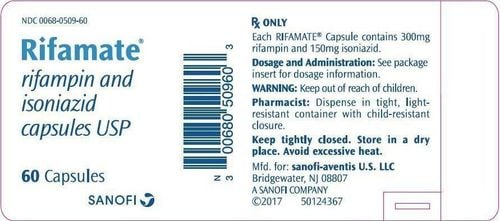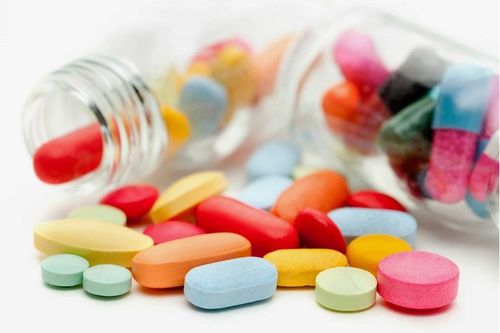This is an automatically translated article.
Zefeta drug has the main ingredient Ceftazidime which has been proven effective in killing bacteria. The drug is administered intravenously or intramuscularly. Please refer to the article below for more useful information about this drug.
1. What is Zefeta?
What is Zefeta drug? The Ceftazidime component in Zefeta is known for its bactericidal ability by inhibiting the enzymes that synthesize bacterial cell walls. Ceftazidime is susceptible to many aminoglycoside-resistant gram-negative organisms and gram-positive organisms resistant to ampicillin and other cephalosporins. At the same time, this component is quite stable to most bacterial beta-lactamases except Bacteroides enzymes.
The drug has an antibacterial spectrum that works well with: aerobic gram-negative bacteria including Pseudomonas, E.coli, Proteus, Klebsiella, Shigella, Salmonella, Haemophilus influenza... Some strains of Pneumococcus, Moraxella catarrhalis and beta-hemolytic Streptococcus and Streptococcus viridans...
Ceftazidime is not active against methicillin-resistant Staphylococcus aureus, Enterococcus, Listeria monocytogenes, Bacteroides fragilis, Campylobacter spp., Clostridium difficile.
2. Uses of Zefeta
Zefeta is effective in the treatment of the following conditions:
Lower respiratory tract infections such as: pneumonia, lung abscess, bronchiectasis, bronchiolitis, .. Skin and skin structure infections. Urinary tract infections, both complicated and uncomplicated: pyelonephritis, prostatitis, cystitis, UTI... Bone and joint infections. Gynecological infections. Abdominal infection. Central nervous system infections, including meningitis. Besides. The drug is also effective in the treatment of infectious conditions in the following cases:
Severe infections in patients with impaired immune function due to blood. Severe infections such as burn infections. Infections associated with peritoneal dialysis or with continuous outpatient peritoneal dialysis (CAPD Zefeta drug has a variety of uses in the treatment of infections and infections. However, in some cases below, the drug is not recommended. Prescribing permission to ensure patient safety:
Patients with hypersensitivity to any ingredient of the drug Patients with hypersensitivity to cephalosporin antibiotics Contraindication here should be understood as contraindication. absolute, that is, for no other reason that contraindications can be flexible in taking the drug.
3. Dosage and usage of the drug Zefeta
Dosage and administration of the drug Zefeta as follows:
3.1. How to use Zefeta is indicated for use by intravenous infusion or deep intramuscular injection. For deep intramuscular injections, the healthcare provider will inject into the upper quadrant of the buttocks or the lateral part of the thigh.
Here are some instructions for mixing solution for infusion:
Solution for intramuscular injection is made as follows: Dilute the drug (Ceftazidime 1g) in 3ml distilled water for injection, or 0.5% lilocaine hydrochloride solution or first%. Solution for intravenous injection: The medical staff will mix Ceftazidime 1g in 10 ml of distilled water for injection. Distilled water can be replaced with 0.9% sodium chloride solution or 5% dextrose solution. 3.2. Dosage The dose of Zefeta will depend on the patient's health condition and the purpose of treatment. Patients can refer to the dosage below:
Dosage in adults is 1g every 8 hours or 2g every 12 hours. Dosage in patients with renal impairment will be adjusted according to creatinine clearance. Specifically: Creatinine clearance (ml/min) 50-31 is recommended dose of 1 gram, injection time is every 12 hours. Creatinine clearance (ml/min) 30-16 is recommended dose of 1 gram, injection time is every 24 hours. Creatinine clearance (ml/min) 15-6 is recommended dose of 1 gram, injection time is every 24 hours. Creatinine clearance (ml/min) <5 recommended dose of 500 mg, injection time is every 48 hours. The dose in neonates < 4 weeks of age is 30 mg/kg intravenously, the injection time is every 12 hours. Dosage in neonates 1 month to 12 years: 30-50 mg/kg intravenously up to 6g/day, injection time is every 8 hours. Dosage for the elderly: as prescribed by the doctor, but absolutely do not exceed the dose of 3g per day. Overdosage with Zefeta has been particularly common in patients with renal impairment. Some signs of overdose such as: convulsions, encephalopathy, tremor, neuromuscular excitability.... When experiencing this condition, the patient should be taken to a medical facility immediately. instantly. Your doctor may recommend hemodialysis or peritoneal dialysis to eliminate the drug quickly.
4. Zefeta side effects
In order to ensure the effectiveness of treatment as well as put the patient's health benefits first, the doctor has considered the benefits as well as the risks of the drug. However, during treatment, the drug can still produce some side effects. When these symptoms arise, it is important to notify your doctor for prompt treatment.
Patients may experience symptoms such as: swelling at the injection site, hypersensitivity, itchy rash, diarrhea, nausea, vomiting and abdominal pain....
Common side effects tend to be It disappears on its own after a few days or weeks. The above is not a complete list of Zefeta side effects. Therefore, when any unusual symptoms appear, the patient should be cautious and consult a doctor.
5. Zefeta drug interactions
There have been reports of drug interactions between Zefeta and some drugs such as aminoglycoside antibiotics, chloramphenico, diuretics.
This condition is understood as an interaction between one drug and another. The result of this process will make the drug increase or decrease the therapeutic effect, or give rise to some unwanted effects that are detrimental to the patient.
Therefore, to avoid this situation, you should actively make a list of all your medications (including prescription, nonprescription, herbal and dietary supplements) and show them to your doctor or pharmacist. and consulting.
Medications in general and Zefeta in particular may interact with alcohol, beer or certain foods. Therefore, patients should consult their doctor about the use of these ingredients during treatment with Zefeta.
6. Be careful when using Zefeta
To use the drug safely, patients need to use kidney drugs in the following cases:
Some patients with a history of gastrointestinal diseases should consider the benefits of the drug to outweigh the risks. Because the drug is administered intravenously, there is an increased risk of vasoconstriction. Intravenous use in large quantities may cause vasculitis. Note that in the process of injecting the drug should be injected at a slow rate. After mixing the medicine, it must be used immediately. If not in use, you can store this solution for up to 6 hours at room temperature or within 72 hours in the refrigerator. Zefeta has been evaluated for safety in pregnant women through numerous clinical studies. The drug can be excreted in breast milk, so women who are breast-feeding should consult their doctor about the use of the drug. In cases where medication is required, the mother can stop breastfeeding. Zefeta has the main ingredient Ceftazidime, which has been proven effective in killing bacteria. The drug is administered intravenously or intramuscularly. Patients need to strictly follow the instructions of the doctor and medical staff performing the infusion to ensure effectiveness and avoid unwanted side effects.
Follow Vinmec International General Hospital website to get more health, nutrition and beauty information to protect the health of yourself and your loved ones in your family.













